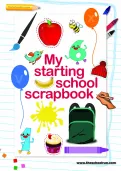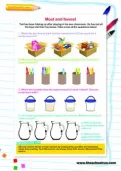Important update from TheSchoolRun
For the past 13 years, TheSchoolRun has been run by a small team of mums working from home, dedicated to providing quality educational resources to primary school parents. Unfortunately, rising supplier costs and falling revenue have made it impossible for us to continue operating, and we’ve had to make the difficult decision to close. The good news: We’ve arranged for another educational provider to take over many of our resources. These will be hosted on a new portal, where the content will be updated and expanded to support your child’s learning.
What this means for subscribers:
- Your subscription is still active, and for now, you can keep using the website as normal — just log in with your usual details to access all our articles and resources*.
- In a few months, all resources will move to the new portal. You’ll continue to have access there until your subscription ends. We’ll send you full details nearer the time.
- As a thank you for your support, we’ll also be sending you 16 primary school eBooks (worth £108.84) to download and keep.
A few changes to be aware of:
- The Learning Journey weekly email has ended, but your child’s plan will still be updated on your dashboard each Monday. Just log in to see the recommended worksheets.
- The 11+ weekly emails have now ended. We sent you all the remaining emails in the series at the end of March — please check your inbox (and spam folder) if you haven’t seen them. You can also follow the full programme here: 11+ Learning Journey.
If you have any questions, please contact us at [email protected]. Thank you for being part of our journey it’s been a privilege to support your family’s learning.
*If you need to reset your password, it will still work as usual. Please check your spam folder if the reset email doesn’t appear in your inbox.
What is a school nursery?

Around the time of their child’s third birthday, many parents begin to think about sending them to a childcare setting that’ll prepare them for starting school.
For some, this will be an independent preschool or nursery, but many others choose to enrol their child in a school nursery.


Claim A FREE Starting School Scrapbook!
- Packed with colourful activities
- Focuses on early English, maths & science skills
- Supports your child’s physical and social development
School nurseries: the basics
As the name suggests, school nurseries are attached to a maintained (‘state’) primary school, academy or free school.
They are on the same site and often work closely with the Reception class.
Some schools have a combined Nursery and Reception class. Some have separate classes but with a lot of crossover time where children from both classes can interact freely. And some keep the nursery class separate.
Some schools now offer provisions for younger children and have 2-year-old Nursery classes, but parents would need to contact the school to find out if this is available.
The nursery class must be led by a qualified teacher, and there must be at least one other staff member with a level 3 childcare qualification.
Staff-to-child ratios are different in terms of the school environment and the staff’s level of qualification. Unlike the small ratios in other settings, there must be at least one staff member for every 13 children.
Many school nurseries are flexible, so you may be able to choose whether your child attends mornings, afternoons or full days.
Children in nursery classes typically wear school uniform or a variant of it (such as joggers with the school jumper). They often join in with the rest of the school in activities such as lunchtime routines, playtime, assemblies, school plays and sports day. This helps them integrate with older children and learn some of the routines of the school day in readiness for starting Reception.
School nurseries are open in term-time only. They may run full-day or half-day sessions. They’ll also have INSET days at the same time as the rest of the school.
Nursery classes are inspected by Ofsted at the same time as the rest of the school.
What do children learn in a school nursery?
Children in nursery classes follow the curriculum for the Early Years Foundation Stage (EYFS), which also includes Reception.
There are seven areas of learning:
- Communication and language, including listening, speaking and understanding
- Physical development, including moving and handling, and health and self-care
- Personal, social and emotional development, including self-confidence and self-awareness, managing feelings and behaviour, and making relationships
- Literacy
- Maths
- Understanding the world
- Expressive arts and design
Children take part in a range of learning activities, such as listening to stories, beginning to learn phonics, counting and measuring, singing and making music, drawing and painting, and PE, along with a lot of free play.
They learn through a combination of child-led and adult-led activities. There are three specific types of learning:
- Playing and exploring: investigating and experiencing things, and ‘having a go’
- Active learning: concentrating and persevering if they encounter difficulties, and enjoying their achievements
- Creating and thinking critically: developing their own ideas, making links between ideas, and developing strategies for doing things.
There’s no formal assessment for nursery children. Instead, staff observe what they’re doing and shape their learning experiences based on their interests and level of development and achievement.
You should be kept up to date about your child’s progress. This might be through parent-teacher consultations, and/or a record book or learning log where staff note down their observations.
Do you have to pay for school nursery?
All children are entitled to 15 hours of funded childcare per week for 38 weeks per year from the start of the term after their third birthday.
Many others are entitled to 30 hours, depending on eligibility.
You can use your funding for a school nursery place for your child (although bear in mind that not all school nurseries are open for 30 hours per week).
School nurseries can’t charge additional fees on top of your child’s funding. They can, however, charge for ‘extras’ like meals, snacks, and nappies (by law, there’s no obligation for children to be toilet trained when starting nursery, although it’s preferable if they are).
How do you apply for a school nursery place?
Unlike Reception places, there are no fixed nationwide application dates and deadlines for nursery classes, so you’ll need to check with the school.
Find a nursery school place for children under 5 in England and Wales on the .gov website.
Application criteria will also vary from school to school. For example, some may prioritise children in a particular catchment area or siblings of current pupils. You can find the school’s admissions policy on its website.
It’s always a good idea to visit the school before you apply for a place. They may run tours of the nursery class or allow you to visit at a time that suits you.
What are the pros and cons of a school nursery?
The choice about whether to send your child to a school nursery is a personal one. However, you may want to take the following pros and cons into account:
Pros
- A school nursery will help your child get used to their future school environment and the routines of the school day.
- They’ll get to interact with other children who may be in their Reception class, and to get to know other children and teachers in the wider school.
- Starting school properly will feel less nerve-wracking as they’ve already had a gentle introduction to school life.
- They’ll be taught by a qualified teacher rather than a nursery worker.
- You won’t have to pay for their childcare, other than for extras like snacks.
- They may be encouraged to be more independent than in a private childcare setting, for example with toileting, hygiene and dressing themselves.
- Their learning will give them a good foundation to build on in Reception, for example through starting phonics and basic numeracy.
- If they have an older sibling at the same school, it may be more convenient to have both children on the same site than in two (or more) different settings.
Cons
- School nurseries are only open during the school day and in term-time, and may not offer 30 hours per week. This could be difficult if you work.
- There may be up to 13 children per staff member, rather than up to eight children in a private nursery or pre-school, and up to 30 children per class.
- Usually, there is no guarantee that children in a nursery class will get a Reception place at the same school.
- Although learning is through play, you may feel it’s more formal than in a private nursery or pre-school.
- The school environment and routines (e.g. changing for PE and going to assembly) may feel overwhelming for your child.
- You’re likely to have less day-to-day communication with staff, and instead have termly parent-teacher consultations.
- Your child will mix with older pupils, up to Year 6: you may prefer them to be in a specific Early Years setting.
- Additional expenses for things like snacks and meals, and wraparound care if you need it, can add up.
‘We’d advise that parents should choose whichever setting is best for them and their child, rather than basing it on whether it’s a school nursery or private voluntary or independent setting,’ says a spokesperson from the Early Years Alliance.
‘Why we chose a school nursery’
‘In our area, the vast majority of children move from pre-school to nursery in the year before starting Reception, so we decided to do the same with Sam. He was also beginning to outgrow his pre-school, and we felt he was ready for a change.
Being in the nursery class helped Sam to get used to school life so that when he started Reception, it wasn’t a big deal at all. He was already used to wearing uniform, going to assembly and even choosing picture books to bring home, as well as doing simple phonics and numeracy.
Children in nursery and Reception also got to move freely between the two classrooms during part of the morning, so Sam got to know the Reception environment and the teacher.
The vast majority of his class stayed at the school for Reception, and we could tell that the new joiners found it harder to integrate as the nursery children had formed friendships already.
One drawback was that the Nursery teacher had high expectations more in line with older children, so sometimes it felt that she expected too much from her class. I was called in once and reprimanded because Sam had torn a book: he was only just three!
It would also have been useful to have the option of full days, and some holiday childcare.
Overall, though, sending Sam to Nursery was definitely the right decision, and we did the same with our second child, too.’
Alison, mum to Sam, nine, and Daisy, six








